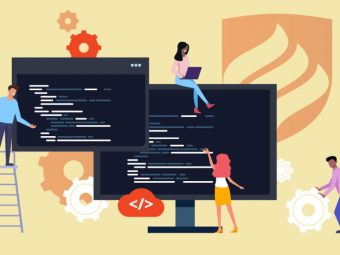Apple Mac For Absolute Beginners
Tags: Mac Basics
Everything you need to know about the Mac computer, its basic hardware, software, features and functions
Last updated 2022-01-10 | 4.6
- Students will be able to identify the functions of all the major aspects of the Mac computer- its hardware
- included software
- saving
- storing and sorting files
- troubleshooting - what to do if things go wrong and how it fits in with the rest of your e-devices
What you'll learn
* Requirements
* All that's needed to make this class a success is a Mac computer - desktop or laptopDescription
This online class is designed for absolute beginners - people that have recently been given or have bought a Mac, desktop or laptop, it doesn't really matter. People who need to understand basic operations, what the supplied software does, learn basic filing and data storage routines, how to back-up and save your stuff, and most importantly, what to do if things go wrong.
I have taught this class in a face-to-face format for over six years at Sydney University adult education centre - and have now converted more than 20 years of user experience into an easy-to-access and highly informative online resource.
Who this course is for:
- This class is ideal for anyone just starting out with a Mac computer. Doesn't matter how old you might be, or your level of computer experience, this is the class for you...
Course content
10 sections • 84 lectures
Introduction and Contents Preview 02:28
Here's a brief introduction to my comprehensive Mac class for absolute beginners...
New Features in OS Catalina Preview 01:19
Here's a listing of what's new to OS Catalina
Buying a Mac: Processor speed Preview 03:04
If you are buying a new Mac, here's some information about the central processing unit, or CPU. If you have already bought your Mac, this will give you an idea of just how fast your computer is likely to be.
Buying a Mac: Hard Drive Storage Preview 04:37
Here's a brief overview on the three basic types of hard drive currently available for Mac computers at the retail point of sale: traditional SATA style drives, solid state (SSDs) and newer technology hybrid drives. If you already have a Mac computer - desktop or laptop - it's hard (read expensive) to change what's already in the box - so your best option might be to look at buying more storage in the form of a desktop hard drive. You can pick one up in most electronics, computer and office supplies stores (see separate section Expanding the Mac's Storage for more information).
Buying a Mac: Adding RAM Preview 04:17
RAM or random access memory is one of the few things that you can buy and add to any computer to give it a performance boost. For the sake of economy most Macs are sold with less than an ideal amount of RAM installed - adding more makes it perform better and it will also help future proof your investment.
Buying a Mac: Plug and Play Connectivity Preview 06:57
Unfortunately Apple changes its ports (read 'sockets') on a frequent basis - this means that a hard drive you bought a few years ago might not even fit the ports provided on a new machine. Here's a brief overview on the different Mac ports available.
Hard Drives Explained Preview 04:37
A brief video overview of what to expect when buying an external hard drive (see also the next lecture: Expanding the Mac's Storage).
Expanding Mac Storage: External Drives Preview 03:28
More information on the types of external hard drive available for the busy Mac user needing more storage room.
About USB Ports Preview 02:14
Not all USB ports deliver enough power to drive the units plugged into them - in particular with some of the older legacy units with older-style USB 2.0 ports. Here's one solution...
Bluetooth Accessories Preview 01:43
Since Bluetooth became popular there have been a plethora of quality entertainment and productivity-enhancing additions to the Bluetooth gadget line up...
Discounted Mac Computers? Preview 01:50
Apple is one of the stingiest tech companies around, rarely, if ever, offering anything other than a minimal discount on its products. Here's how you might score a discount...
The Dock: What does it do? Preview 03:28
The Dock, that strip of icons that magically pops up from the bottom of the screen each time you point the cursor at it, is where the Mac keeps its application shortcuts.
Learn here how to add new (software) icons, or replace existing ones if they get (accidentally) deleted.
Searching for files with Spotlight Preview 03:10
Spotlight is a fast, intuitive search feature in the Mac OS, first introduced by Apple in 2005. Use it to find files and applications on your Mac system - very quickly.
Spotlight also has the ability to add other locations to your search, providing information about items that sound like the word searched for, plus further information via online assets such as Wikipedia, Maps, the Internet in general and more.It's a brilliant feature.
Mac keyboard shortcuts Preview 00:49
Here are 20 of my top keyboard shortcuts to try. There are, of course, plenty more, but these should get you started nicely.
The About This Mac panel Preview 05:35
Though something of a dry topic, the About this Mac information window is useful especially if you need to upgrade the RAM in the computer, discover how much storage remains (i.e. hard drive space), its manufacturing date (crucial when ordering spares for the computer) and much, more.
Quick Look mode Preview 02:45
The Mac operating system offers first time users a staggering array of ways to present information visually: pictures, graphics, documents, PDFs, and more, can all be viewed up close using the simple, but highly effective Quick Look mode.
Just tap the Space Bar to get an up front, and huge, enlargement of any file thumbnail.
Finder: Red. Orange and Green buttons Preview 03:36
What do those three colour buttons do on every Mac Finder or application window really do?
Mojave OS:Dark Mode Preview 03:33
Finder: View Modes Preview 03:32
The Finder is a window used to 'see' into folders and other levels of the computer to help you find documents, photos, videos, presentations, and more...
Finder: Adding multiple Tabs to Finder Preview 02:36
Adding tabs to a Finder window is one way to clean up your screen, work faster, and generally be more efficient...
Adding the Finder to the Dock Preview 00:31
The Mac operating system offers many ways to distribute and display data - this tutorial shows you how to drag a folder full of files to the Dock so its content, irrespective of what's in it, can be viewed with a single point of the cursor.
Finder: Adding/Renaming sidebar shortcuts Preview 03:59
Apple provides a default set of menu items in the Finder window (i.e. 'Documents', 'Applications', 'Desktop', 'Downloads', etc). You might never use all those links, so learn how to remove them, and then learn how to add new links for your own stuff.
Copying and Pasting Files Preview 07:25
Copying and pasting single or multiple files, or even multiple folders full of files, is a quick and efficient way to keep your stuff exactly where you need it to be on the hard drive.
How to copy Files from an External Disk Preview 02:30
Here's a simple way to get files (documents, .pdfs, photos, presentations or videos) from your Mac on to an external drive (USB stick or hard drive).
How to Format a New Disk Preview 01:31
Learn how to use the Mac Disk Utility to format and name a new hard drive or USB stick
How to Partition a new Drive Preview 01:40
Apple's Disk Utility allows you to split a (new) hard drive into multiple partitions - effectively making them appear as different drives (an essential process if you plan on loading Windows onto the Mac using Boot Camp).
Ejecting Disks Preview 03:06
Unlike the PC, it's important to follow the correct protocol when removing any disk from the Mac. As usual, there's more than one way to get this task done...
Simple Copy and Paste Techniques Preview 07:25
In this lesson learn how to select single and multiple files, how to copy and paste files, and how to drag and drop those files from one location to another.
Shuffling Applications Preview 01:35
If you are running multiple applications simultaneously things can get muddled onscreen. Use this simple keyboard shortcut to quickly search through a mess of open programs and windows.
Screen Shots and Screen Videos Preview 04:03
Easily record a still image or a video directly off your screen
Productivity: Using the Arrange Tab Preview 06:10
A great way to display files through its Arrange Tab. Set it up to display files by their: Date Modified tag, Type of File (i.e. Word doc, Powerpoint, Excel, etc), Date Created, and so on. This feature is a huge help to anyone sorting through loads of different files.
Productivity: Renaming Files in Bulk Preview 02:54
Giving your files proper names helps you keep track of your home and office projects. In this tutorial I show you how to rename multiple files on one go...
File Management with Colour Tags Preview 05:23
Learn how to apply colour tags to files and folders to make it easier to navigate, sort and order your digital stuff.
File Management: Customising Tags Preview 02:02
Learn how to make your own Custom Tags - to make your file management more personal and above all, easier to manage.
Updating your Operating System Preview 01:50
Occasionally Apple publishes a free update to the operating system - learn how to find out if there is a new version and if there is, how to go about installing it.
Where are your Apps? Preview 02:00
As the title suggests, this tutorial shows you where the software 'lives' once installed on the Mac.
Finding, Downloading, Installing Software Preview 07:07
Downloading and installing software for the first time?
Here's how its done, with advice about what the (downloaded) file should look like (i.e. a '.pkg' or '.dmg' file) and what to do if it turns out to be an '.exe' file (an executable file - these are for a PC and won't work on the Mac - but they might also be an Internet-borne virus accidentally downloaded from an email attachment. In most cases these malicious files do not affect a Mac).
Deleting files with Trash Preview 04:01
Learn how to select individual files, or groups of files in one easy motion. You'll also learn how to deselect files if they get accidentally selected as a group. Learn how to drag files to the Trash for permanent removal from the computer.
Learn how to check how much space there is on your computer's hard drive using the About this Mac window.
Searching for applications with Launchpad Preview 02:02
Use this impressive one-press utility to locate, and open, applications. It's easy to use - hit the icon on the Dock, or press the F4 key...
Organising Launchpad Preview 01:45
Launchpad is Apple's feature for locating all your applications - it works brilliantly but once you have installed a load of applications you will need to get them organised into folders. Here's how.
Adding multiple desktops: Mission Control Preview 04:05
In this tutorial learn how to create multiple desktops. Do this to make it easier to view multiple applications or web pages - by putting a single app or web page on each 'desktop'. Then easily flick between these 'desktop views' using the keyboard shortcut: Control + the Right, or Left arrows on the keyboard. It's like having several separate simplified screens that you can flick through at will.
Dock: Stacks Preview 01:52
The Stacks feature allows users to view files in a different way off the Dock.
Desktop: Stacks Preview 02:17
Excellent feature used to clean up a crowded desktop area
Adding Widgets with Dashboard (Legacy) Preview 03:44
Located inside the Mac Dashboard feature, a widget is really a tiny little app, like a web page, that provides instant information on a wide range of specialised topics.
You can download widgets that play selected radio stations, keep you up to date with the NASDAQ, the outside temperature, news headlines - and there's even a very handy Thesaurus.
You can even make your own widgets (via Safari) or download load hundreds of free ones off the Apple Site.
iBooks Preview 02:45
Introduced with Mac's Yosemite operating system, iBooks gives you the power to browse, sample and buy books from a library with thousands of titles, including some freebies.
Runs on your Mac and IOS device.
Apple Maps Preview 04:13
Apple Maps looks like Google maps - but that's where the comparisons stop. It is full of intuitive features such as turn-by-turn spoken directions (only on IOS devices), fast searching, proactive suggestions, information on taking public transport, indoor maps and the best of all (in my opinion), flyover mode - a brilliant 3D photographic representation of many world-wide locations.
It's a great trip planning tool.
Notifications Preview 03:14
Learn to use Apple Notifications to receive alerts from applications - either from Apple software, or Apps from third party software.
Use Notifications to keep up to date with your messages, emails, the weather, meetings and more - all without having to open each parent software application to read the messages. Apple brings everything into one window - on the Mac, iPhone and iPad.
System Preferences: General - fine tuning appearences Preview 05:36
Although there's little or nothing that needs adjusting in the Mac once it's up and running, the System Preferences are a great way to add little customised differences to the way you work and see the information. For example, learn how to change highlight colours, adjust the way scroll bars appear, set a default web browser, and more.
Changing the Desktop Image Preview 03:14
Apple provides Mac users with a raft of superb pictures to display as a desktop image. Watch this tutorial to learn how to change that desktop picture - to a different Apple-supplied image, a flat colour background, or one of your own stunning creations!
Dynamic Desktop Images Preview 02:14
A special desktop image that changes brightness in tandem with the local time!
Preferences: Text to Speech (pre OS Catalina) Preview 02:54
This is neat little utility that comes as part of the Dictation and Speech module found in the System Preferences. Switch this feature On, open a web or book page, right-click and choose 'Start speaking' to listen to the text being read by a voice called Karen (the 'preset' voice) or another of your choice. Warning: If you use a different voice, it has to be downloaded first. Although fun to listen to, most of the voice files are huge (i.e. 1Gb+) so if they are never going to be used, delete them off your computer to save space, or stick with Karen.
Preferences: Speech to Text (pre OS Catalina) Preview 04:30
As part of its service to help speech and sight impaired people, Apple provides a neat feature that listens to your spoken word and converts it into editable text. Perfect for hands-free operations, dictating notes, or writing long passages of text, especially if typing isn't your strong point. This feature will save you a heap of time and effort.
Speech to Text (OS Catalina) Preview 04:11
How to convert the spoken work into editable text
Mouse: Customising how it works Preview 03:23
The mouse just plugs in and works, right? Actually it's possible to adjust several features of the mouse to make it work better for your style, and speed.
Trackpad: Customising how it works Preview 01:11
If you are new to the Mac computer, and especially to using a trackpad (found on laptops, or as a Bluetooth extra that can be used on any computer), use this great little preferences feature to get the most out of this tool (see Apple Trackpad original and Trackpad 2 JPEG file in downloadable materials).
The APP Store Preview 02:47
Here's a quick overview of the App Store, an online digital asset store.
Seamless backups using Time Machine Preview 06:17
Like many of Apple's features, Time Machine, a seamless data backup feature, is very easy to set up and use. All that's needed is a new external hard drive, a few minutes and Time Machine is up and running. Once the initial backup has been performed, it continues to back up your data - in the background - so you never really notice it happening.
And if you accidentally delete a file, open Time Machine, go back 'in time' to a date before the item was deleted, and simply re-instate the file to where it was originally. Sounds like magic and works like magic.
Working with Bluetooth devices Preview 02:25
Bluetooth is a short distance wireless service designed specifically for connecting devices such as mice, keyboards, headphones, external speakers and more. It's an easy process to instigate and is there to assist as you move into a cable-free lifestyle.
Working with Wireless features Preview 02:56
Learn how easy it is to set up your computer's wireless internet connection.
Boot Camp: Installing Windows on your Mac Preview 03:56
Two computer operating systems in one? Boot Camp is a utility that's designed to guide owners through the process of installing Windows operating system onto your Mac. It's relatively easy to do and quick - the only thing you have to purchase to make this work is a license for the Windows operating system and you are off. You can then set the Mac to boot either as a PC or as a Mac. This is especially useful if you work on both platforms and have spent money on PC-only software.
Parallels Software: Running Windows and the Mac OS simultanaeously Preview 02:36
Although all Mac computers come with Boot Camp, a standalone utility that allows you to install Windows onto your Mac, you can only run one operating system at any one time: Mac or PC.
Specialist software such as Parallels or VMware Fusion 10 allow you to set up Windows so it runs side-by-side with the Mac operating software, enabling you to hot-swap files back and forth between operating systems. It's also a good setup for testing products that you might be designing for cross-platform performance. (Note: Though you can do this on almost any Mac, it's probably best to set this up on a new machine before the hard drive(s) becomes short on free space). If you try this on an established system, you'll have to first copy everything off the hard drive before formatting it for Mac OS and PC.
Apple Mail - part 1 Preview 01:33
Apple Mail is a great little App for managing your emails - here's how to set your first account up.
Apple Mail - part 2 Preview 04:13
Learn about the basic Mail functions to start using this Apple App.
Apple Mail - part 3 Preview 03:55
Although it looks simple, Apple Mail provides the user with a range of very sophisticated tools - such as a Smart Mailbox.
Safari: Setting up the Home Page Preview 04:31
Safari is Apple's signature internet browser. Here's a short tutorial on how to set up the Home page.
Safari: Saving Favourites and Top Sites Preview 04:16
Use this tutorial to set your favourite web site for instant viewing. Plus learn about Safari's Top Sites feature where your Favourites are displayed visually - a very neat design feature.
Word processing: Apple Pages Preview 12:53
Pages is Apple's own special word processing software. At first glance this looks to be a basic application but you'll soon appreciate that it comes packed with powerful features that take your simple document creation into the world of semi-professional page layout and graphic design.
Presentations: Apple Keynote Preview 12:58
The best way to describe Keynote is that it's an elegant version of Powerpoint, the PC industry's standard presentation software produced by Microsoft.
While Powerpoint is ubiquitous, Keynote offers a level of sophistication in its graphics, templates and general design 'look' that's hard to beat. And of course, as with most Apple software, it's easy to output the final document in a range of Mac and PC-friendly formats for universal distribution.
Apple Photos Preview 18:36
A short overview of this simple but powerful photo editor
Photos: Making a digital picture book Preview 10:19
Apple always included this book making software as part of iPhoto - which has subsequently been replaced by its Photos software. It's elegant and easy to put a beautiful coffee table picture book together using your images and Apple's range of styles and designs.
Apple iMovie (part 1) Preview 03:26
Like most of the applications that come pre-loaded on the Mac, iMovie is relatively easy to get to grips with while providing a level of video editing sophistication that's hard to beat.
Let's take a look at how to set this program up and get stuck into making your first movie.
Apple iMovie (part 2) Preview 08:10
In a continuation of the previous introduction, I show you how to arrange clips on the timeline, modify the sound output from each clip as well as adding a soundtrack before finishing the project by outputting it to one of many different social media locations (Facebook, YouTube, Vimeo etc), or just to the desktop.
Apple iMovie (part 3) Preview 04:19
Learn how to polish your video production by adding, editing and modifying transitions between clips.
Apple iMovie (part 4) Preview 08:22
Like many Apple applications, iMovie comes loaded with features - especially so in terms of being able to adjust the colour, brightness, contrast, and even the stability of any clips in the timeline. It's a surprisingly sophisticated tool.
Apple iTunes (Legacy pre-Catalina) Preview 03:52
Apple iTunes is synonymous with music and a whole lot more media. In this tutorial I run through the various uses for iTunes including as a basic media player, an inspirational music source, online music store, a podcast player, access to radio stations, TV programs and feature films.
Over the years iTunes has become a mega media warehouse.
iTunes evolution on Mac OS Catalina Preview 03:12
iTunes is now three Apps: Apple Music, Apple Podcast and Apple TV
Apple Numbers Preview 01:39
Numbers is Apple's version of Microsoft's Excel. Though Excel has total market dominance, Numbers presents data in a unique and pleasing way, making it visually appealing - and therefore somewhat less dry when compared to the competition. Here's a brief overview of what it can do...
Apple GarageBand Preview 01:23
As its name might suggest, GarageBand is an app designed for musicians and recording artists alike.
It ships with a complete sound library that includes instruments, presets for guitar and voice, and an incredible selection of session drummers and percussionists. As Apple describes this program: "With Touch Bar features for MacBook Pro and an intuitive, modern design, it’s easy to learn, play, record, create and share your hits worldwide. Now you’re ready to make music like a pro".
Emergency: How to Force Quit an application Preview 02:04
As the name suggests, occasionally applications get jammed - they refuse to budge, so it's time to force them to quit - learn how to do this without having to reboot the entire system.
Disk Utility: Running a health check on your Mac OS Preview 04:51
Very occasionally the Mac operating system runs into problems and you might notice the computer's performance suffering as a result. If this is the case you can take the offending device to the nearest Apple store for a check up, or run Disk Utility from your own desktop. This is a great bit of software that can scan, identify and (usually) repair possible issues, thus saving you a time-consuming, and often expensive trip to the computer doctor...
Dealing with the BBoD (Beach Ball of Death) Preview 06:16
Tips on what to do if your computer 'freezes'
How to Safely Uninstall an Application Preview 03:25
How to remove or uninstall an application
iCloud Basics Preview 03:33
Learn something about the Internet, or more precisely, iCloud: what it is, how to log into your iCloud account plus advice on what to use and what to keep (switched) off to avoid running out of storage space.
Internet Security Preview 06:39
We all need Internet security and while Apple computers are less likely to fall prey to malicious intrusion than PCs, it still pays to be careful when going online...








 This course includes:
This course includes:














